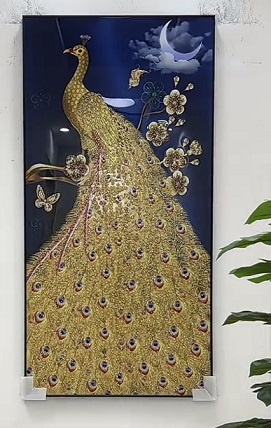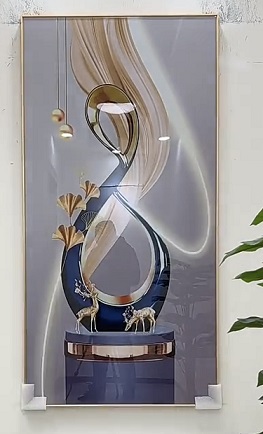Symbolism in Chinese Decorative Paintings: Cultural Significance and Popular Appeal
- By : Eileen
The decorations cherished by Chinese people are typically imbued with profound cultural significance, with each ornament bearing a specific meaning and blessing. The design and choice of these adornments are often intricately linked to Chinese traditional culture, historical narratives, philosophical ideologies, and folk beliefs.
In Chinese culture, auspicious and serene decorations hold deep cultural connotations and carry rich symbolic meanings. Throughout ancient China, auspicious motifs like dragons, phoenixes, good fortune, longevity, and the double happiness symbol were prominently featured in embroidery and woven textiles, as well as in clothing. These patterns served not only as adornments but, more significantly, as carriers of people’s hopes for luck, health, prosperity, and long life.
Traditionally, such decorations were believed to attract good fortune and repel evil spirits, making them ubiquitous in major festivals, celebrations, weddings, and daily life. For instance, during the Spring Festival, Chinese households adorn their doors with Spring Festival couplets and the character “Fu,” symbolizing the arrival of blessings and good fortune in the New Year. Similarly, at weddings, the presence of the double happiness symbolizes abundant joy and marital bliss.
This deep-seated appreciation for auspicious decorations stems from people’s faith and their anticipation of auspicious events in the future, a tradition that has endured for millennia in Chinese culture.

luck, health, prosperity 
Lucky Peacock
Chinese culture reveres the sentiment of a “bright future” and its associated decorations, as the phrase itself embodies well-wishes for success and prosperity ahead. In Chinese, the idiom “Qiancheng Sijin” translates directly to “the road ahead is as beautiful as brocade,” symbolizing an anticipation of hope, smoothness, and abundance in the future.
Emphasizing expectations for the future, Chinese culture often sees individuals expressing their good wishes to loved ones in various ways. On significant occasions such as the Spring Festival, birthdays, weddings, and graduations, decorations and gifts featuring the theme of a “bright future” and related auspicious imagery hold particular appeal. Calligraphy and painting pieces, embroidered fabrics, decorative pendants, among other items adorned with phrases or motifs representing a “bright future,” are commonly chosen as gifts to convey the giver’s optimistic hopes for the recipient’s future.
Furthermore, traditional Chinese culture places great emphasis on allegorical meanings, often conveying positive messages through both words and visual patterns. Thus, the concept of a “bright future” not only serves as a source of joy and upliftment but also functions as a form of psychological support, encouraging individuals to face the future with a positive outlook.

bright future
The concept of a “big family” holds significant appeal for Chinese people, deeply rooted in traditional cultural and social values. In ancient China, a sizable family and a thriving family enterprise symbolized wealth and achievement. A large family ensured the continuity of the bloodline and the preservation of the family lineage, while a prosperous family business signified a solid economic foundation.
Moreover, the notion of a “big family” is intertwined with China’s agrarian heritage. In traditional agrarian societies, possessing more land and manpower translated to enhanced productivity, leading to greater economic prosperity and social standing. Consequently, the pursuit of familial greatness equated to the pursuit of material abundance and social prestige.
Furthermore, China’s social structure places considerable emphasis on the collective welfare of the family and community over individual pursuits. A large family offers an extensive support network, facilitating various aspects of life such as family business endeavors, children’s education, and eldercare. This harmonious familial cohesion is perceived as a cornerstone of social stability.
While modern lifestyles and family dynamics have evolved over time, many Chinese individuals continue to prioritize family unity and prosperity as fundamental life aspirations. The ideal of a “great cause” remains deeply entrenched in the hearts of many, reflecting a steadfast commitment to familial well-being and societal harmony.



